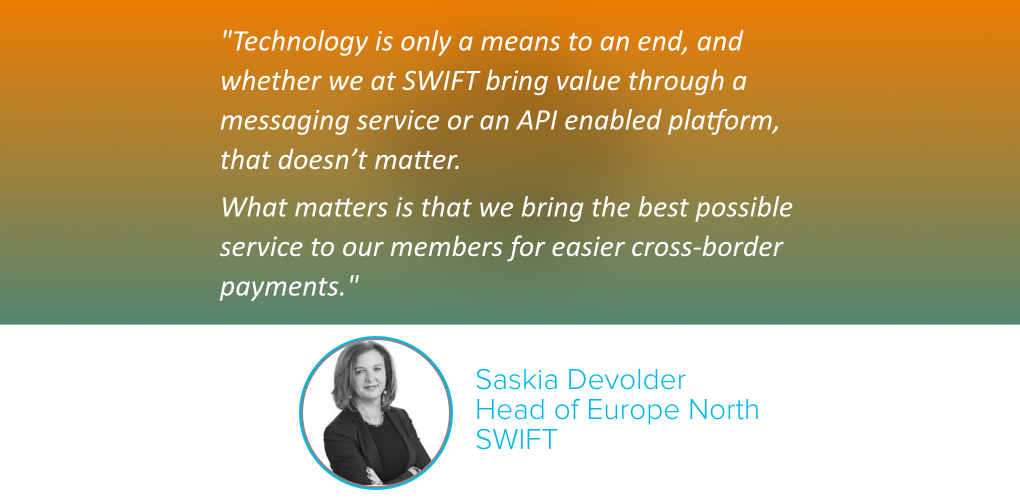
Insights & Opinions
Shaping the Future of Financial Services - The Power of Collaboration
Wed, 28 Oct 2020

At a time when everyone talks about partnerships with start-ups and scale-ups, we have a tendency to almost forget one of the most obvious collaborations in financial services.
Back in 1973, a group of banks from around the world came together and founded SWIFT as a cooperative, with a mission to replace telex communication by a completely automated messaging service. Nearly five decades on, SWIFT’s global community reflects the complexity and diversity of the financial ecosystem and SWIFT continues to be owned by its clients, who are instrumental in defining its strategy.
A few weeks after Sibos, we welcomed Saskia Devolder, Head of Europe North at SWIFT, to discuss the past, present and future of SWIFT’s ecosystem and the role of collaboration therein.
A history of collaboration
What started in 1973 as a project to automate transaction processing has now become a complete portfolio of services linked to the processing of payments and securities, predominantly cross-border.
Since the very beginning, SWIFT has dedicated a lot of time and energy to understanding the needs of its clients. The organisation has always kept its finger on the pulse through regular fora and meetups, including but not limited to member groups, user groups, the Board and its various committees, as well as the yearly conference Sibos and the SWIFT Institute.
With customers in more than 200 countries and territories, the rise of the agile way of working came as a blessing: developments started to grow more organically, and the feedback from the community became a more integrated part of the innovation process.
Saskia: “Over the past couple of years, we have looked for more co-creation in the development of our products. With the technologies that are now available, we can involve our customer more along the way and with better outcomes. This has all helped us to get even closer to our customers than before.”
SWIFT gpi paved the way for SWIFT’s new strategy
In recent years, SWIFT gpi has played a dominant role in co-creation with the community. SWIFT gpi has also set the foundations for SWIFT’s new strategy, with the ambition to bring the speed and STP-rate of cross-border payment execution in line with that of domestic payments. Of course, cross-border and domestic payments are two different processes, given that cross-border payments are inherently more complex.
In a regular cross-border payment, you follow the A-B-C-D route. The sequenced way of working can be time-consuming and expensive. Each entity in the chain has its own responsibilities and single point of contact.
Saskia gives the example of sanctions screening: “In most cases, domestic payments do not need screening for sanctions, which is a requirement for cross-border payments. In the case of a cross-border payment today, banks screen incoming traffic, outgoing traffic and, in the example of the sequence of bank A-B-C-D, every bank involved in the chain runs their own screening on the same transaction. ”
SWIFT gpi allows banks to track-and-trace payments and connect member bank counterparties, all in one place, with an immediate impact on the STP-rate, transparency and cost of execution of a transaction. It also requires gpi banks to adhere to a service level agreement for the execution of cross-border payments.
In the settlement of transactions that cover multiple time zones, where market infrastructures are not open 24/7, initiatives like SWIFT gpi are essential to speed up the process. By connecting gpi to instant payments systems such as TIPS or RT1, SWIFT has shown that cross-border payments from Singapore to Europe, for example, can be executed in less than a minute.
For transactions that cannot be executed in seconds, such as those to countries with currency controls, SWIFT gpi’s track-and-trace and pre-validation bring value in another way. The higher transparency through SWIFT gpi sets the right expectations for the originating customer, and it reduces the effort at the bank.
Saskia: “Pre-validation creates a lot more transparency, both on execution as well as on the cost of the transaction. The more STP we can have, and the faster exceptions can be managed, the lower the cost will be.”
From a messaging service to a platform business
Saskia: “gpi is part of the foundation of the business strategy. First of all, gpi has proven that it doesn’t take 2–3 days for a cross-border payment to move from originating to the beneficiary account. Today we see that 92% of gpi payments are executed within 24h, and 40% of those transactions are executed in 30 minutes. That is OK, but not good enough yet.”
Shortly before this year’s virtual Sibos, SWIFT announced its new strategy, and its ambition to move from a sequenced business model to a platform model. The new platform will be the central source of truth for each cross-border payment and that central data for the transaction will be available for all parties involved in the processing.
In the future, compliance checks can be made simultaneously, improving efficiency and speed. The model allows for the originating bank to correspond immediately and directly for additional requests whenever required.
In the mid to long term, communication with the platform will be predominantly through ISO 20022 messages, a format that allows much richer, and more structured data. In turn, this will create new possibilities and innovations that make the life of bank customers easier.
Saskia: “Many market infrastructures have adopted the same approach as Europe when it comes to ISO 20022 migration; they have chosen not to go for what we call “like for like”. By going the whole way and adopting the richness of data that ISO 20022 has to offer, rather than just copying the fields in a FIN message to ISO 20022, a lot more value can be created.”
The platform is an open system, meaning that other providers can connect through APIs. Service providers that require additional reference data for fraud detection and AML can connect to the SWIFT platform to speed up cross-border payments and to increase the STP rate.
On top of that, the platform allows for each member to adopt the changes at its own pace. Saskia: “We have 11.000 customers, and there may be some, for very good reasons, that don’t adopt changes immediately.
With the new platform, we work with what we call backwards compatibility, meaning that we allow everyone to move at its own pace. So the innovative banks can benefit from the advantages of the platform from the beginning. Those that cannot afford to do so immediately can wait a bit longer to adapt and to take advantage of the platform.”
Whether it is in fraud management, sanction screening or cybersecurity, SWIFT helps its members to improve resilience, reduce costs and improve the STP rate of cross-border payments. By moving these services to a mutualised platform, this evolution will accelerate, resulting in even lower costs for its members.
Saskia: “Banks screen the same transaction plenty of times. If we want to speed up the process and reduce the cost of every transaction, why do we keep all screening? Can’t we say we screen only once, in the middle and we agree that this screening can be trusted by everyone involved?”
Like with most innovations and improvements, technology is not the problem. The complexity lies in agreements on responsibilities and liabilities. The complexity lies in the negotiations with regulators to make sure everyone agrees with the one single truth. Collaboration is a complex process, but the benefits are clear for all.
The power of collaboration to shape the future of finance
By reducing the cost of executing cross-border payments, SWIFT will make its platform more accessible to implement new use cases and scenarios to shape the future of finance, cost-effectively. For every scenario that arises, it will closely monitor what value can be added by building on its strengths.
One example is the case of cross-border e-commerce.
Saskia: “If cross-border transactions in an e-commerce environment can move instantly in an account-to-account environment, why would I opt for another payment method?”
Another example is that of API-enabled finance.

SWIFT believes that if you combine the use of APIs with the platform business model, the possibilities are endless.
Saskia: “Technology is only a means to an end, and whether we at SWIFT bring value through a messaging service or an API enabled platform, that doesn’t matter. What matters is that we bring the best possible service to our members for easier cross-border payments.”
In everything SWIFT does, it asks itself the question of how it will bring more value to the community. As the people it does business with are its very own shareholders, SWIFT always looks for new ways to improve its services and to help its members to improve the service for their customers.
In that respect, Saskia believes that challengers, organisations that rethink the cross-border transactions business, are of immense value to them.
Saskia: “We love them because those challengers force us to keep innovating, to keep thinking about how we can bring more value to the community. We need those challengers, because like in every market, whatever product you sell, you need some healthy competition to keep you innovating and creating always better products for the market.”



